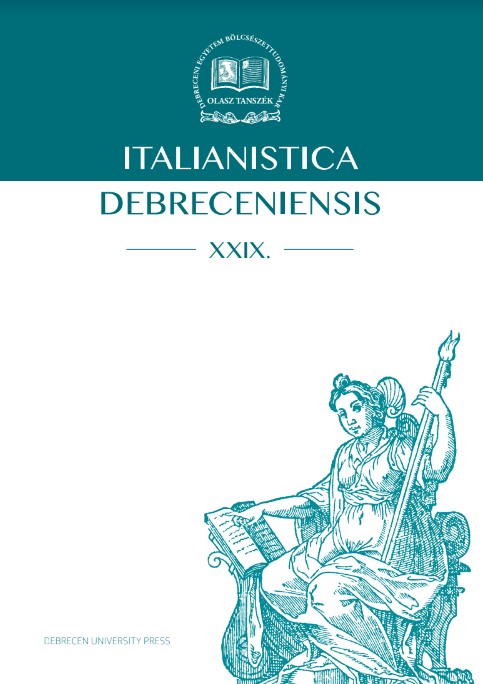Alfabetizzazione sanitaria, traumi della migrazione, medicina narrativa e sportello linguistico. Nuove pratiche nel translinguismo e processi educativi
Author
View
Parole chiave
Licenza

Questo volume è pubblicato con la licenza Creative Commons Attribuzione 4.0 Internazionale.
How To Cite
Abstract
L’Health Literacy (HL) è un campo complesso che comprende una serie di attività di educazione sanitaria e di comunicazione che sono cruciali per l’interazione con il sistema sanitario. In un mondo sostenibile, l’assistenza sanitaria del futuro deve essere accessibile a tutti e dobbiamo garantire che le persone provenienti da un contesto migratorio abbiano le risorse per gestire la propria salute. Le disuguaglianze nei profili sanitari degli immigrati, segno di politiche di integrazione inefficaci, potrebbero essere mitigate migliorando i livelli di HL. Lo scopo dello studio è quello di indagare lo spazio dato all'HL all'interno dei contesti di apprendimento formale degli immigrati; lo studio prevedeva la somministrazione di un questionario che voleva essere un'indagine su alcuni bisogni e disagi specifici legati alla condizione del translinguismo e ai relativi traumi, che possono avere un impatto negativo sull'apprendimento della lingua. Tale intreccio offre una prospettiva diversa che genera nuove pratiche didattiche e la creazione di uno Sportello Linguistico che attraverso il linguaggio, l’alfabetizzazione sanitaria e la medicina narrativa promuove contesti di apprendimento equi, sicuri e sostenibili che valorizzano l’esperienza del translinguismo in tutte le sue forme.
Riferimenti bibliografici
- Bacharack N. L., Heck T. W., Dahlberg K. (2008), Co-Teaching In Higher Education, in «Journal of College Teaching & Learning (TLC)», 5 (3), pp. 9-16.
- Bassnett S. (2014), Translation, Abingdon and New York, Routledge.
- Bhabha H. K. (1994), The Location of Culture, London, Routledge.
- Borri M., Calzone S. (2019), L’istruzione degli adulti in Italia. I CPIA attraverso le voci degli attori, Pisa, Edizioni ETS.
- Calabrese S., Conti V., Fioretti C. (2022), Che cos’è la medicina narrativa, Roma, Carocci.
- Carbonara V., Scibetta A. (2020), Imparare attraverso le lingue. Il translanguaging come pratica didattica, Roma, Carocci.
- Caringi J. C., Stanick C., Trautman A., Crosby L., Devlin M., Adams S. (2015), Secondary traumatic stress in public school teachers: contributing and mitigating factors, in «Advances in School Mental Health Promotion», 8 (4), pp. 244-256. doi: 10.1080/1754730X.2015.1080123
- Cassiani P., Mattioli L., Parini A. (2010), Facile Facile, Pesaro, Nina Edizioni.
- Castro Schepers O., Brennen M., Bernhardt P. E. (eds.) (2022), Developing Trauma Informed Teachers: Creating Classrooms that Foster Equity, Resiliency, and Asset-Based Approaches: Reflections on Curricula and Program Implementation, Charlotte, NC, Information Age Publishing.
- Cook L., Friend M. (1995), Co-teaching: Guidelines for creating effective practices, in «Focus on Exceptional Children», 28 (3), pp. 1-17.
- De Micco V. (2017), Trauma migratorio, in «La ricerca. SpiWeb» (https://www.spiweb.it/la-ricerca/ricerca/trauma-migratorio/; last accessed: 6/11/2023).
- de Rogatis T. (2023), Homing/Ritrovarsi, Traumi e translinguismi delle migrazioni in Morante, Hoffman, Kristof, Scego e Lahiri, Siena, Edizioni Università per Stranieri di Siena (https://doi.org/10.1093/heapro/daaa157; last accessed: 6/11/2023).
- Frigessi Castelnuovo D., Risso M. (1982), A mezza parete. Emigrazione, nostalgia, malattia mentale, Torino, Einaudi.
- Kottler J. (2015), Stories we’ve heard, stories we’ve told. Life-changing narratives in therapy and everyday life, Oxford, Oxford University Press.
- Lorini C., Caini S., Ierardi F., Bachini L., Gemmi F., Bonaccorsi G. (2020), Health Literacy as a Shared Capacity: Does the Health Literacy of a Country Influence the Health Disparities among Immigrants?, in «International Journal of Environmental Research and Public Health», 17 (4), pp. 1-20. doi.org/10.3390/IJERPH17041149.
- Lorini C., Bonaccorsi G. (2022), L’alfabetizzazione sanitaria nelle scuole di vario ordine e grado: sottoprodotto dell’alfabetizzazione o valore aggiunto per futuri cittadini
- più pronti?, in M. Buccolo, V. Ferro Allodola (eds.), Medical Humanities & Medicina Narrativa, Roma, Aracne, pp. 85-102.
- Nutbeam D. (1986), Health promotion glossary, in «Health Promotion International», 1 (1), pp. 113-127. doi.org/10.1093/heapro/1.1.113.
- Nutbeam D. (2000), Health literacy as a public health goal: a challenge for contemporary health education and communication strategies into the 21st century, in «Health promotion International», 15 (3), pp. 259-267. doi.org/10.1093/heapro/15.3.259.
- Nutbeam D., Muscat D. (2021), Health Promotion Glossary 2021, in «Health promotion International», 36 (6), pp. 1578-1598.
- Riggs E., Yelland J., Duell-Piening P., Brown S.J. (2016), Improving health literacy in refugee populations, in «Medical Journal of Australia», 204 (1), pp. 9-10. doi.org/10.5694/MJA15.01112.
- Sayad A. (2004), The Suffering of the Immigrant, Cambridge, Polity (trans. David Macey).
- Smith B. J., Cho Tang K., Nutbeam D. (2006), WHO Health Promotion Glossary: new terms, in «Health Promotion International», Volume 21, Issue 4, pp. 340-345. doi.org/10.1093/heapro/dal033”doi.org/10.1093/heapro/dal033
- Thüne E. M., Lupp i R. (2022), Lingua, identità e memoria. Il lavoro con biografie linguistiche nella didattica universitaria. Un’introduzione, in R. Lupp i, E. M. Thüne (eds.), Biografie linguistiche. Esempi di linguistica applicata, Bologna, Amsacta, pp. 1-14.
- Unhcr = United Nations High Commissioner for Refugees (2022), Global Trends. Forced displacement in 2022, (https://www.unhcr.org/global-trends-report-2022; last accessed: 6/11/2023).
- Van Den Broucke S. (2014), Health literacy: a critical concept for public health, in «Arch Public Health», 72 (1):10, pp. 1-2.
- Vedovelli M. (2000), Modelli sociolinguistici e glottodidattici per nuovi bisogni comunicativi, in E. Piemontese (ed.), Lingue, culture e nuove tecnologie, Quaderni del Giscel, Firenze, La Nuova Italia, pp. 13-40.
- Wenzlaff T. L., Berak L., Wieseman K., Monroe-Baillargeon A., Bacharach N. L., Bradf ield-Kreider P. (2002), Walking our talk as educators: Teaming as a best practice, in E. Guyton, J. Rainer (eds.), Research on Meeting and Using Standards in the Preparation of Teachers, Dubuque, IA, Kendall-Hunt Publishing, pp. 11-24.
- Who = World Health Organization (1948), Constitution of the World Health Organization,(https://apps.who.int/gb/bd/PDF/bd47/EN/constitution-en.pdf?ua=1 last accessed: 6/11/2023).
- Who = World Health Organization (2021), Health Promotion Glossary of Terms, (https://www.who.int/publications-detail-redirect/9789240038349; last accessed 6/11/2023).
- Who = World Health Organization (2023), The health of refugees and migrants in the Who European Region, (https://www.who.int/europe/news-room/fact-sheets/item/ the-health-of-refugees-and-migrants-in-the-who-european-region; last accessed: 6/11/2023).

 https://doi.org/10.34102/itde/2023/14224
https://doi.org/10.34102/itde/2023/14224